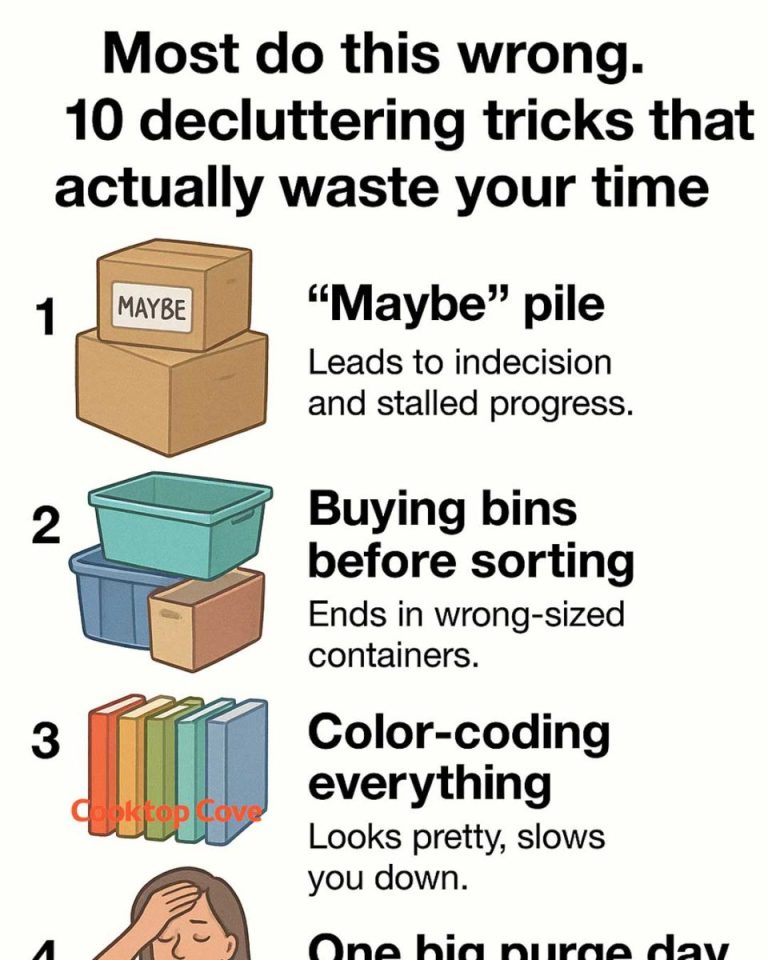Most do this wrong. 10 decluttering tricks that actually waste your time

1. The Maybe Pile: A Recipe for Indecision
Creating a 'maybe' pile is a common practice during decluttering sessions. The idea is to set aside items you are unsure about and decide on them later. However, this often leads to prolonged indecision and clutter that lingers. Instead of making a decision, you end up with a pile of items that take up space and mental energy.
To avoid this trap, set clear criteria for what stays and what goes before you start decluttering. If an item doesn't meet your criteria, let it go immediately. This approach reduces the need for a 'maybe' pile and helps you make quicker, more confident decisions.
2. Buying Bins Before Sorting: A Costly Mistake
Many people rush to buy storage bins and containers before they even start decluttering. While organizing tools can be helpful, purchasing them prematurely can lead to wasted money and space. You may end up with bins that don't fit your needs or items that don't require storage.
Instead, sort through your belongings first and determine what you truly need to keep. Once you have a clear idea of what needs to be stored, you can purchase the appropriate storage solutions. This ensures that your storage is both functional and cost-effective.
3. Color Coding Everything: Aesthetic Overload
Color coding can be a visually appealing way to organize, but it can also become overwhelming and impractical. When every item is assigned a specific color, it can lead to confusion and frustration, especially if you have a large number of items.
Instead of color coding everything, focus on categorizing items based on their function or usage. This approach is more intuitive and easier to maintain. Reserve color coding for specific areas where it truly enhances organization, such as in filing systems or clothing storage.
4. The One Big Purge Day: Overwhelming and Unsustainable
The idea of dedicating an entire day to decluttering can seem appealing, but it often leads to burnout and incomplete projects. Tackling everything at once is overwhelming and can result in hasty decisions or fatigue.
Instead, break your decluttering into smaller, manageable tasks. Set aside a few hours each week to focus on specific areas or categories. This approach is more sustainable and allows you to maintain momentum without feeling overwhelmed.
5. The 'Just in Case' Mentality: Holding Onto Unnecessary Items
Keeping items 'just in case' you might need them in the future is a common decluttering mistake. This mentality leads to holding onto items that are rarely, if ever, used, resulting in unnecessary clutter.
To combat this, ask yourself how likely you are to use the item in the near future. If you haven't used it in the past year and don't foresee a specific need for it, consider letting it go. This mindset shift can help you release items that no longer serve a purpose in your life.
6. Sentimental Hoarding: When Memories Become Clutter
Sentimental items often hold emotional value, making them difficult to part with. However, keeping too many sentimental items can lead to clutter that detracts from the memories they represent.
To manage sentimental clutter, select a few key items that truly capture the essence of your memories. Consider taking photos of items you wish to remember but don't need to keep physically. This allows you to preserve the memory without the physical clutter.
7. The 'Out of Sight, Out of Mind' Trap: Hidden Clutter
Stashing items out of sight can create the illusion of a tidy space, but it often leads to hidden clutter. Items stored in closets, drawers, or storage units can accumulate and become forgotten.
Instead of hiding clutter, aim to create a system where everything has a designated place. Regularly review stored items to ensure they are still needed and used. This practice prevents hidden clutter from building up and keeps your space truly organized.
8. Over-Organizing: When Systems Become Too Complex
Creating overly complex organizational systems can be counterproductive. When systems require too much effort to maintain, they are often abandoned, leading to disorganization.
Focus on simplicity when organizing. Choose systems that are easy to use and maintain, such as clear labeling and straightforward storage solutions. A simple system is more likely to be sustained over time, ensuring long-term organization.
9. The 'Touch It Once' Rule: Inefficient for Decluttering
The 'touch it once' rule suggests handling each item only once to make a decision. While this can be effective in some scenarios, it can be inefficient during decluttering, where thoughtful consideration is needed.
Instead of rushing decisions, take the time to evaluate each item carefully. Consider its value, usefulness, and emotional significance. This approach may take longer initially, but it leads to more intentional and lasting decluttering results.
10. Decluttering Without a Plan: Lack of Direction
Starting a decluttering project without a clear plan can lead to chaos and frustration. Without direction, you may find yourself moving items around without making meaningful progress.
Before you begin, outline a plan that includes specific goals, areas to focus on, and a timeline. Having a plan provides structure and motivation, helping you stay on track and achieve your decluttering objectives.
11. Ignoring Emotional Attachments: The Emotional Toll of Decluttering
Decluttering can be an emotional process, especially when dealing with items that have sentimental value. Ignoring these emotions can lead to stress and difficulty letting go of items.